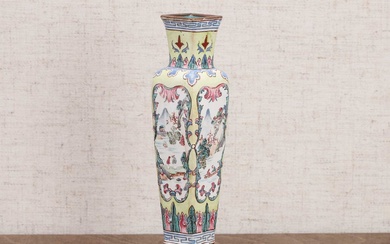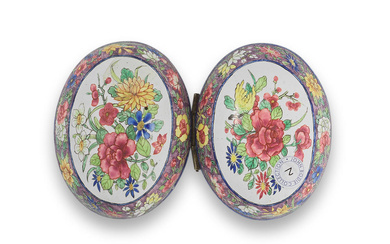A FINE AND RARE PAINTED ENAMEL AND GILT-BRONZE SQUARE VASE
Qianlong
Qianlong
Of slender square section tapering form, delicately enamelled with cusped panels variously depicting Xiwangmu borne on clouds with a boy attendant offering a dish of peaches, and Magu with a further boy attendant in a rocky landscape, all on a bright yellow ground with a profusion of flower sprays and foliage, the neck with archaistic pendent lappets on a pink ground within key-fret bands, set with a pair of gilt bronze lion-mask handles, with hongmu stand. 16.5cm (6 1/2in) high. (2).
清乾隆 銅胎畫琺瑯開光仕女圖長方形瓶
Provenance:
J. C. Vickery, London
E. A. Parry (1879-1946), London, acquired from the above on 25 August 1924, and thence by descent
Published, Illustrated and Exhibited:
Royal Academy of Arts, International Exhibition of Chinese Art, London, 1935-1936, p.186, no.2187.
來源:
倫敦古董商J. C. Vickery
倫敦E. A. Parry(1879-1946)舊藏,於1924年8月25日購自上者,並由後人保存迄今
展覽著錄:
皇家藝術學院,《中國藝術國際展覽會》,倫敦,1935-1936年,頁186,編號2187
This remarkable vase was included in the International Exhibition of Chinese Art held at the Royal Academy of Arts, Burlington House, London, in 1935-1936. This seminal exhibition had the patronage of their Majesties King George V and Queen Mary, and the President of the Chinese Republic. It included over 3,000 objects. These were variously loaned by the Chinese Government, including pieces shown for the first time outside China, objects from the collection of Sir Percival David, which were exhibited for the first time in public, pieces from the British Royal Collection, and from many important museums including the British Museum, the V&A, the Louvre, Guimet, Cernuschi, Topkapi Saray, the Metropolitan Museum of Art, Cleveland, Kansas City, Cologne, Dresden, and by notable private collectors including HRH Crown Prince of Sweden, Alan Barlow, R.C. Bruce, Buchanan-Jardine, Mr & Mrs Alfred Clark, Dr Leonard Gow, C.T. Loo, Carl Kempe, H.J. Oppenheim, Oscar Raphael, F. Schiller, Mr & Mrs Walter Sedgwick, A. Stoclet , S.D. Winkworth and Prof. W. Perceval Yetts - a roll call of the greatest collectors of Chinese art in the West in the 20th century. E.A. Parry loaned 6 pieces to the Exhibition, demonstrating the superb quality of the Collection and the high esteem in which it was held by the Exhibition Committee, which was directed by Sir Percival David. These pieces were admired to this date in the Parry family homes and this is the first time since the 1935-1936 Exhibition that they are seen in public once again.
During the Qianlong period, the southern port of Guangzhou (otherwise known as Canton) was the main trade entrepot between Europe and China. Influenced by European painted enamels and oil paintings, local craftsmen began producing a large number of painted enamel wares depicting foreign flowers, architecture and Western figures as well as Chinese Immortals and subject matter which were sent as tribute to the Imperial Court in Beijing. Apart from the Guangzhou workshops, a smaller number of painted enamel wares were also manufactured in the Imperial Workshops in the Forbidden City, Beijing, which were first established during the reign of the Kangxi Emperor.
Xiwangmu, the Queen Mother of the West, shown on one side of the vase, is a Daoist deity often depicted with an assistant carrying a basket of peaches beside her, such as on the present lot. She has an orchard of peaches deep in the Kunlun mountains in the West, which when eaten bestow Immortality. Magu, shown on the other side, is another female Immortal associated with the elixir of life. She is often portrayed next to a basket of flowers or herbs with life-giving properties.
Compare the painting of Xiwangmu with another similar female Immortal on a painted enamel vase, Qianlong seal mark and period, in the Qing Court Collection, illustrated in Compendium of Collections in the Palace Museum: Enamels, 5, Beijing, 2011, pp.106-107, no.72. Compare also the dense foliate scrolls with similar ones on two Imperial-tribute painted enamel vases, Qianlong seal marks and of the period, illustrated in Ibid., nos.119 and 120.
本拍品曾借展1935至1936年於倫敦皇家藝術學院伯靈頓宮舉辦的中國藝術國際展覽會。這一史無前例的展覽得到了中英政府及雙方人士的大力支持,由雙方元首擔任名譽主持人,英王喬治五世和瑪麗王后為監理。展品共計三千餘件,中國政府應邀出借包括故宮文物在內的近千件藏品,也是藏品首次在中國境外展出;展覽還包括了英國皇室的中國文物收藏,以及來自世界各地重要博物館(如大英博物館、維多利亞和阿爾伯特博物館、盧浮宮、吉美博物館、賽努奇博物館、託卡比皇宮博物館、大都會藝術博物館、克利夫蘭藝術博物館、堪薩斯城納爾遜-阿特金斯藝術博物館、科隆博物館、德累斯頓博物館等)與著名私人藏家(如瑞典王儲、Alan Barlow爵士、R.C. Bruce、Buchanan-Jardine男爵、克拉克伉儷(Mr & Mrs Alfred Clark)、Leonard Gow博士、盧芹齋、卡爾·坎普(Carl Kempe)、H.J. Oppenheim、Oscar Raphael, F. Schiller、Walter Sedgwick伉儷、A. Stoclet、S.D. Winkworth、W. Perceval Yetts教授等)的公私收藏精品,名單幾乎囊括了二十世紀西方世界最為重要的中國藝術收藏家。 E.A. Parry向本次展覽出借了六件藏品,這也顯示了其收藏品味之卓越及展覽籌備委員會對其之激賞。展覽結束後,Parry氏藏品淡出公眾視野,僅供家族成員賞玩;本次拍賣是1936年以來本品首次出現在公眾面前。
瓶呈方形,脖頸與腹下內收,使器身四面交界線呈弧形,方中有圓而更顯委婉多姿。外壁以三匝藍色回紋為界,頸於粉地之上繪變形蕉葉紋,頸部以下滿飾黃地雜色花卉,兩側飾獸鈕。器身前後作葉形開光繪仙人像。其一手持靈芝駕於雲上,身旁童子手捧仙桃;另一攜花籃與采芝童子行於山中,或為西王母和麻姑之形象。
十五世紀中葉,歐洲發明了畫琺瑯的製作技法,後隨海運貿易往來以及西方傳教士呈進傳入中國。清初畫琺瑯製品經由粵海關入境時,就地設廠研製,称之为「洋磁」;康熙年間始設內務府造辦處琺瑯作,開始燒造畫琺瑯器;至雍正朝,已經形成了內廷琺瑯處和廣州、蘇州三大畫琺瑯生產中心。
本例所飾人物形象可比較清宮舊藏一例清乾隆畫琺瑯開光仕女圖撇口瓶,見《故宮博物院藏品大系·琺瑯器編5:清畫琺瑯》,北京,2011年,頁106-107,編號72。同書亦收錄兩例清乾隆畫琺瑯開光山水人物圖貫耳壺,編號119與120,所飾花卉紋可與本例比對。
View it on
Sale price
Estimate
Time, Location
Auction House
Qianlong
Qianlong
Of slender square section tapering form, delicately enamelled with cusped panels variously depicting Xiwangmu borne on clouds with a boy attendant offering a dish of peaches, and Magu with a further boy attendant in a rocky landscape, all on a bright yellow ground with a profusion of flower sprays and foliage, the neck with archaistic pendent lappets on a pink ground within key-fret bands, set with a pair of gilt bronze lion-mask handles, with hongmu stand. 16.5cm (6 1/2in) high. (2).
清乾隆 銅胎畫琺瑯開光仕女圖長方形瓶
Provenance:
J. C. Vickery, London
E. A. Parry (1879-1946), London, acquired from the above on 25 August 1924, and thence by descent
Published, Illustrated and Exhibited:
Royal Academy of Arts, International Exhibition of Chinese Art, London, 1935-1936, p.186, no.2187.
來源:
倫敦古董商J. C. Vickery
倫敦E. A. Parry(1879-1946)舊藏,於1924年8月25日購自上者,並由後人保存迄今
展覽著錄:
皇家藝術學院,《中國藝術國際展覽會》,倫敦,1935-1936年,頁186,編號2187
This remarkable vase was included in the International Exhibition of Chinese Art held at the Royal Academy of Arts, Burlington House, London, in 1935-1936. This seminal exhibition had the patronage of their Majesties King George V and Queen Mary, and the President of the Chinese Republic. It included over 3,000 objects. These were variously loaned by the Chinese Government, including pieces shown for the first time outside China, objects from the collection of Sir Percival David, which were exhibited for the first time in public, pieces from the British Royal Collection, and from many important museums including the British Museum, the V&A, the Louvre, Guimet, Cernuschi, Topkapi Saray, the Metropolitan Museum of Art, Cleveland, Kansas City, Cologne, Dresden, and by notable private collectors including HRH Crown Prince of Sweden, Alan Barlow, R.C. Bruce, Buchanan-Jardine, Mr & Mrs Alfred Clark, Dr Leonard Gow, C.T. Loo, Carl Kempe, H.J. Oppenheim, Oscar Raphael, F. Schiller, Mr & Mrs Walter Sedgwick, A. Stoclet , S.D. Winkworth and Prof. W. Perceval Yetts - a roll call of the greatest collectors of Chinese art in the West in the 20th century. E.A. Parry loaned 6 pieces to the Exhibition, demonstrating the superb quality of the Collection and the high esteem in which it was held by the Exhibition Committee, which was directed by Sir Percival David. These pieces were admired to this date in the Parry family homes and this is the first time since the 1935-1936 Exhibition that they are seen in public once again.
During the Qianlong period, the southern port of Guangzhou (otherwise known as Canton) was the main trade entrepot between Europe and China. Influenced by European painted enamels and oil paintings, local craftsmen began producing a large number of painted enamel wares depicting foreign flowers, architecture and Western figures as well as Chinese Immortals and subject matter which were sent as tribute to the Imperial Court in Beijing. Apart from the Guangzhou workshops, a smaller number of painted enamel wares were also manufactured in the Imperial Workshops in the Forbidden City, Beijing, which were first established during the reign of the Kangxi Emperor.
Xiwangmu, the Queen Mother of the West, shown on one side of the vase, is a Daoist deity often depicted with an assistant carrying a basket of peaches beside her, such as on the present lot. She has an orchard of peaches deep in the Kunlun mountains in the West, which when eaten bestow Immortality. Magu, shown on the other side, is another female Immortal associated with the elixir of life. She is often portrayed next to a basket of flowers or herbs with life-giving properties.
Compare the painting of Xiwangmu with another similar female Immortal on a painted enamel vase, Qianlong seal mark and period, in the Qing Court Collection, illustrated in Compendium of Collections in the Palace Museum: Enamels, 5, Beijing, 2011, pp.106-107, no.72. Compare also the dense foliate scrolls with similar ones on two Imperial-tribute painted enamel vases, Qianlong seal marks and of the period, illustrated in Ibid., nos.119 and 120.
本拍品曾借展1935至1936年於倫敦皇家藝術學院伯靈頓宮舉辦的中國藝術國際展覽會。這一史無前例的展覽得到了中英政府及雙方人士的大力支持,由雙方元首擔任名譽主持人,英王喬治五世和瑪麗王后為監理。展品共計三千餘件,中國政府應邀出借包括故宮文物在內的近千件藏品,也是藏品首次在中國境外展出;展覽還包括了英國皇室的中國文物收藏,以及來自世界各地重要博物館(如大英博物館、維多利亞和阿爾伯特博物館、盧浮宮、吉美博物館、賽努奇博物館、託卡比皇宮博物館、大都會藝術博物館、克利夫蘭藝術博物館、堪薩斯城納爾遜-阿特金斯藝術博物館、科隆博物館、德累斯頓博物館等)與著名私人藏家(如瑞典王儲、Alan Barlow爵士、R.C. Bruce、Buchanan-Jardine男爵、克拉克伉儷(Mr & Mrs Alfred Clark)、Leonard Gow博士、盧芹齋、卡爾·坎普(Carl Kempe)、H.J. Oppenheim、Oscar Raphael, F. Schiller、Walter Sedgwick伉儷、A. Stoclet、S.D. Winkworth、W. Perceval Yetts教授等)的公私收藏精品,名單幾乎囊括了二十世紀西方世界最為重要的中國藝術收藏家。 E.A. Parry向本次展覽出借了六件藏品,這也顯示了其收藏品味之卓越及展覽籌備委員會對其之激賞。展覽結束後,Parry氏藏品淡出公眾視野,僅供家族成員賞玩;本次拍賣是1936年以來本品首次出現在公眾面前。
瓶呈方形,脖頸與腹下內收,使器身四面交界線呈弧形,方中有圓而更顯委婉多姿。外壁以三匝藍色回紋為界,頸於粉地之上繪變形蕉葉紋,頸部以下滿飾黃地雜色花卉,兩側飾獸鈕。器身前後作葉形開光繪仙人像。其一手持靈芝駕於雲上,身旁童子手捧仙桃;另一攜花籃與采芝童子行於山中,或為西王母和麻姑之形象。
十五世紀中葉,歐洲發明了畫琺瑯的製作技法,後隨海運貿易往來以及西方傳教士呈進傳入中國。清初畫琺瑯製品經由粵海關入境時,就地設廠研製,称之为「洋磁」;康熙年間始設內務府造辦處琺瑯作,開始燒造畫琺瑯器;至雍正朝,已經形成了內廷琺瑯處和廣州、蘇州三大畫琺瑯生產中心。
本例所飾人物形象可比較清宮舊藏一例清乾隆畫琺瑯開光仕女圖撇口瓶,見《故宮博物院藏品大系·琺瑯器編5:清畫琺瑯》,北京,2011年,頁106-107,編號72。同書亦收錄兩例清乾隆畫琺瑯開光山水人物圖貫耳壺,編號119與120,所飾花卉紋可與本例比對。







